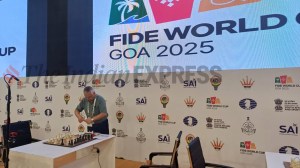Kenzaburō Ōe passes away: The life and legacy of Japanese Nobel-winning author
A prominent dissident and writer with a cult following in post-war Japan, Ōe became the voice of change in a country trying to adapt to new political circumstances.
 Japanese Nobel literature prize winner Kenzaburo Oe at an anti-nuclear gathering in Tokyo in September 2011. (Photo: Reuters)
Japanese Nobel literature prize winner Kenzaburo Oe at an anti-nuclear gathering in Tokyo in September 2011. (Photo: Reuters) Japanese literary giant and author of noted works such as A Personal Matter (1964), A Quiet Life (1964) and the seminal The Silent Cry (1967), Kenzaburō Ōe passed away on March 3, his publisher Kodansha said in a statement on Monday. The 1994 Nobel laureate in Literature was 88.
Famous works and themes
One of Japan’s most celebrated — and controversial — authors, Ōe’s novels, short stories and essays placed him at the confluence of the personal and the political. In his Nobel citation, the Swedish Royal Academy lauded the author’s body of work in which “poetic force creates an imagined world where life and myth condense to form a disconcerting picture of the human predicament today.”
Often compared with William Faulkner in matters of style, several of Ōe’s works, including one of his most well-known collection of essays — Hiroshima Notes (1965) — focus on the grim aftermath of World War II and the consequences of the atomic bombing of Hiroshima and Nagasaki.
He was also interested deeply in the myths and traditions of Okinawa, the southernmost group of Japanese islands, and what the US military occupation did to its culture and communities.
The other event that had the deepest impact on him was the birth of his first son, Hikari, meaning light, with a cranial deformity that resulted in a life-long brain damage. His anguish and eventual acceptance of the event would lead to some of his finest works, such as A Personal Matter, A Quiet Life and Teach Us to Outgrow our Madness (1969).
Ōe wrote more than 40 novels, short story and essay collections. His last book, In Late Style, was published in 2013.
Early life and initiation into writing
One of seven children, Ōe was born in 1935 in Ōse, a village in Shikoku, the smallest of Japan’s four main islands. Seeped in Japan’s storytelling traditions by his mother and grandmother early in his life, Ōe found in them a lifelong refuge, especially after he lost his father in 1944 to World War II. He grew up reading The Adventures of Huckleberry Finn by Mark Twain and The Wonderful Adventures of Nils by Swedish writer Nils Holgersson, which nurtured a lifelong interest in cultural anthropology.
The bombing of Hiroshima and Nagasaki, followed by the surrender of Emperor Hirohito and the American occupation of Japan, would have a profound effect on Ōe, who had been raised as a monarchist. It upended all his previous beliefs, making him a lifelong advocate of democracy and pacifism.
In his Nobel lecture, Ōe said, “In the history of modern Japan literature the writers most sincere and aware of their mission were those ‘post-war writers’ who came onto the literary scene immediately after the last War, deeply wounded by the catastrophe yet full of hope for a rebirth. They tried with great pains to make up for the inhuman atrocities committed by Japanese military forces in Asian countries, as well as to bridge the profound gaps that existed not only between the developed countries of the West and Japan but also between African and Latin American countries and Japan. Only by doing so did they think that they could seek with some humility reconciliation with the rest of the world. It has always been my aspiration to cling to the very end of the line of that literary tradition inherited from those writers.”
After university, Ōe began his career as a journalist, moving on to fiction in 1957, with early works such as Shiiku (1957, a novella), and Nip the Buds, Shoot the Kids (1958).
Legacy
A writer with a cult following in post-war Japan, Ōe became the voice of change in a country trying to adapt to new political circumstances. A prominent dissident, Japan’s second Nobel laureate in Literature after Kawabata Yasunari, Ōe was felicitated and criticised in equal measure for his writing and politics.
In an interview to Paris Review in 2007, Ōe had said, “People say that I’ve been writing about the same things over and over again ever since — my son Hikari and Hiroshima. I’m a boring person. I read a lot of literature, I think about a lot of things, but at the base of it all is Hikari and Hiroshima.”
In the same interview, he said, “…the I-novel is about what happens when the everyday life of the author is interrupted by an unusual or special event — a tsunami, an earthquake, the death of a mother, the death of a husband. It never opens up to a question about the individual’s role in society. My work starts with my personal life, but I try to open up to social issues.”
In 1994, soon after receiving the Nobel, he declined Japan’s highest artistic honour, the Order of Culture, that resulted in a great deal of national outrage, with death threats from imperialist right-wingers. He was also embroiled in a defamation case in 2005 for a 1970 essay, which spoke of the role of Japanese officers in provoking hundreds of Okinawans to commit suicide towards the end of World War II. He eventually won the case.





- 01
- 02
- 03
- 04
- 05
































